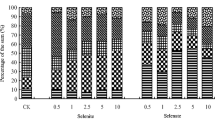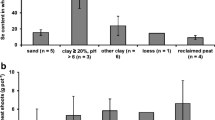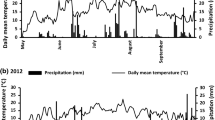Abstract
Selenate fertilization is an effective way to secure selenium (Se) nutrition in Se-poor areas but the cycling of the added selenate in the soil-plant system requires further clarification. We examined the Se uptake efficiency of wheat and ryegrass and Se distribution within these plants in two pot experiments. The behaviour of added selenate in a sand soil under wheat was monitored by sequential extractions during a ten-week growing period. In addition, the relationship between Se uptake of ryegrass and the salt extractable and ligand exchangeable Se in a sand and silty clay soil were studied. The added selenate remained mainly salt soluble in the soil throughout the monitoring. Se uptake by wheat comprised 12% of the soluble Se pool in soil and extended over the whole period of growth. In wheat, over 50% of Se accumulated in grains. The Se uptake of ryegrass comprised, on average, 40% of the soil salt soluble Se. In ryegrass, over 80% of the Se accumulated in roots. The distribution pattern of Se in plants can clearly have a major influence on both the Se cycle in soil and the nutritional efficiency of Se fertilization. The simple salt extraction showed fertilization-induced changes in the soluble soil Se pool, whereas the ligand exchangeable Se fraction reflected the difference in the nonlabile Se status between the two soils.





Similar content being viewed by others
References
Abrams MM, Shennan C, Zasoski RJ, Burau RG (1990) Selenomethionine uptake by wheat seedlings. Agron J 82:1127–1130
Balistrieri LS, Chao TT (1987) Selenium adsorption by goethite. Soil Sci Soc Am J 51:1145–1151
Bisbjerg B, Gissel-Nielsen G (1969) The uptake of applied selenium by agricultural plants 1. The influence of soil type and plant species. Plant Soil 31:287–298
Camps Arbestain M (1998) Effect of straw amendment and plant growth on selenium transfer in a laboratory soil-plant system. Can J Soil Sci 78:187–195
Chang SC, Jackson ML (1957) Fractionation of soil phosphorus. Soil Sci 84:133–144
Combs GF (2001) Selenium in global food systems. Br J Nutr 85:517–547
Dhillon KS, Rani N, Dhillon SK (2005) Evaluation of different extractants for the estimation of bioavailable selenium in seleniferous soils of Northwest India. Aust J Soil Res 43:639–645
Djanaguiraman M, Devi DD, Shanker AK, Sheeba A, Bangarusamy U (2005) Selenium—an antioxidative protectant in soybean during senescence. Plant Soil 272:77–86
Eich-Greatorex S, Sogn TA, Falk Øgaard A, Aasen I (2007) Plant availability of inorganic and organic selenium fertiliser as influenced by soil organic matter content and pH. Nutr Cycl Agroecosyst 79:221–231
Ekholm P (1996) Effects of selenium supplemented commercial fertilizers on food selenium contents and selenium intake in Finland. University of Helsinki, Dissertation
Elrashidi MA, Adriano DC, Workman SM, Lindsay WL (1987) Chemical equilibria of selenium in soils: a theoretical development. Soil Sci 144:141–152
Eurola M, Hietaniemi V (eds) (2000) Report of the selenium monitoring programme 1997–1999. Maatalouden tutkimuskeskuksen julkaisuja Sarja B 24 (In Finnish with English abstract)
Eurola M, Alfthan G, Aro A, Ekholm P, Hietaniemi V, Rainio H, Rankanen R, Venäläinen E-R (2003) Results of the Finnish selenium monitoring program 2000–2001. Agrifood Res Rep 36
Eurola M, Alfthan G, Ekholm P, Levonmäki M, Root T, Venäläinen E-R, Ylivainio K (2008) Results of the Finnish selenium monitoring program 2008. Maa-ja elintarviketalous 132 (In Finnish with English abstract)
Evans LT, Wardlaw IF, Fischer RA (1975) Wheat. In: Evans LT (ed) Crop physiology. Cambridge University Press, Great Britain, pp 101–149
Gissel-Nielsen G, Bisbjerg B (1970) The uptake of applied selenium by agricultural plants 2. The utilization of various selenium compounds. Plant Soil 32:382–396
Girling CA (1984) Selenium in agriculture and the environment. Agric Ecosyst Environ 11:37–65
Goodson CC, Parker DR, Amrhein C, Zhang Y (2003) Soil selenium uptake and root system development in plant taxa differing in Se-accumulating capability. New Phytol 159:391–401
Gourdiaan J, van Laar HH (1994) Modelling potential crop growth processes. Kluwer Academic Publishers, Dordrecht
Hartikainen H, Xue T, Piironen V (2000) Selenium as an anti-oxidant and pro-oxidant in ryegrass. Plant Soil 225:193–200
Hartikainen H (2005) Biogeochemistry of selenium and its impact on food chain quality and human health. J Trace Elem Med Biol 18:309–318
Hawkesford MJ, Zhao F-J (2007) Strategies for increasing the selenium content of wheat. J Cereal Sci 46:282–292
Hopper JL, Parker DR (1999) Plant availability of selenite and selenate as influenced by the competing ions phosphate and sulfate. Plant Soil 210:199–207
Hingston FJ, Atkinson RJ, Posner AM, Quirk JP (1967) Specific adsorption of anions. Nature 215:1459–1461
Hingston FJ, Posner AM, Quirk JP (1972) Anion adsorption by goethite and gibbsite I. The role of the proton in determining adsorption envelopes. J Soil Sci 23:177–192
Keskinen R, Turakainen M, Ekholm P, Yli-Halla M, Seppänen M, Hartikainen H (2007) The effect of sulphur on the growth and selenium concentration of rape. 2nd international Symposium on Trace Elements and Health, Abstracts p 67
Keskinen R, Ekholm P, Yli-Halla M, Hartikainen H (2009) Efficiency of different methods in extracting selenium from agricultural soils of Finland. Geoderma 153:87–93
Koljonen T (1975) The behaviour of selenium in Finnish soils. Ann Agr Fenn 14:240–247
Kumpulainen J, Raittila A-M, Lehto J, Koivistoinen P (1983) Electrothermal atomic absorption spectrometric determination of selenium in foods and diets. J Assoc Off Anal Chem 66:1129–1135
Li H-F, McGrath SP, Zhao F-J (2008) Selenium uptake, translocation and speciation in wheat supplied with selenate or selenite. New Phytol 178:92–102
Lyons GH, Stangoulis JCR, Graham RD (2005a) Tolerance of wheat (Triticum aestivum L.) to high soil and solution selenium levels. Plant Soil 270:179–188
Lyons GH, Genc Y, Stangoulis JCR, Palmer LT, Graham RD (2005b) Selenium distribution in wheat grain, and the effect of postharvest processing on wheat selenium content. Biol Trace Elem Res 103:155–167
Lyons GH, Genc Y, Soole K, Stangoulis JCR, Liu F, Graham RD (2009) Selenium increases seed production in Brassica. Plant Soil 318:73–80
Mayland HF (1994) Selenium in plant and animal nutrition. In: Frankenberger WT Jr, Benson S (eds) Selenium in the environment. Marcel Dekker Inc, New York, pp 29–45
McNeal FH, Boatwright GO, Berg MA, Watson CA (1968) Nitrogen in plant parts of seven spring wheat varieties at successive stages of development. Crop Sci 8:535–537
MTT (2006) The feed tables and feeding recommendations 2006. MTT:n selvityksiä 106. MTT, Jokioinen (In Finnish with English abstract)
Nakamaru Y, Tagami K, Uchida S (2005) Distribution coefficient of selenium in Japanese agricultural soils. Chemosphere 58:1347–1354
Parfitt RL (1978) Anion adsorption by soils and soil materials. Adv Agron 30:1–50
Peng A, Xu Y, Liu JH, Wang ZJ (2000) Study on the dose-effect relationship of selenite with the growth of wheat. Biol Trace Elem Res 76:175–181
Rājan SSS, Watkinson JH (1976) Adsorption of selenite and phosphate on an allophane clay. Soil Sci Soc Am J 40:51–54
Ryden JC, Syers JK (1975) Rationalization of ionic strength and cation effects on phosphate sorption by soils. J Soil Sci 26:395–406
Saha UK, Liu C, Kozak LM, Huang PM (2005) Kinetics of selenite desorption by phosphate from hydroxyaluminium-and hydroxyaluminosilicate-montmorillonite complexes. Geoderma 124:105–119
Seppänen M, Turakainen M, Hartikainen H (2003) Selenium effects on oxidative stress in potato. Plant Sci 165:311–319
Simpson RJ, Lambers H, Dalling MJ (1983) Nitrogen redistribution during grain growth in wheat (Triticum aestivum L.). Plant Physiol 71:7–14
Sippola J (1979) Selenium content of soils and timothy (Phleum pratense L.) in Finland. Ann Agr Fenn 18:182–187
Smith GS, Watkinson JH (1984) Selenium toxicity in perennial ryegrass and white clover. New Phytol 97:557–564
Sors TG, Ellis DR, Salt DE (2005) Selenium uptake, translocation, assimilation and metabolic fate in plants. Photosynthesis Res 86:373–389
Stadlober M, Sager M, Irgolic KJ (2001) Effects of selenate supplemented fertilisation on the selenium level of cereals—identification and quantification of selenium compounds by HPLC-ICP-MS. Food Chem 73:357–366
Terry N, Zayed AM, de Souza MP, Tarun AS (2000) Selenium in higher plants. Annu Rev Plant Physiol Plant Mol Biol 51:401–432
Tveitnes S, Singh BR, Ruud L (1996) Selenium concentration in spring wheat as influenced by basal application and top dressing of selenium-enriched fertilizers. Fertil Res 45:163–167
Vuori E, Vääriskoski J, Hartikainen H, Kumpulainen J, Aarnio T, Niinivaara K (1994) A long-term study of selenate sorption in Finnish cultivated soils. Agric Ecosyst Environ 48:91–98
Wall A, Heiskanen J (2003) Water-retention characteristics and related physical properties of soil on afforested agricultural land in Finland. Forest Ecol Manag 186:21–32
Wang D, Sippola J (1990) Selenium in soil extracts and plants determined by fluorometry. Ann Agr Fenn 29:151–156
Whanger PD (2002) Selenocompounds in plants and animals and their biological significance. J Am Coll Nutr 21:223–232
Williams C, Thornton I (1973) The use of soil extractants to estimate plant-available molybnenum and selenium in potentially toxic soils. Plant Soil 39:149–159
Williams MC, Mayland HF (1992) Selenium absorption by two-grooved milkvetch and western wheatgrass from selenomethionine, selenocystine, and selenite. J Range Manage 45:374–378
Wright MT, Parker DR, Amrhein C (2003) Critical evaluation of the ability of sequential extraction procedures to quantify discrete forms of selenium in sediments and soils. Environ Sci Technol 37:4709–4716
Xue T, Hartikainen H, Piironen V (2001) Antioxidative and growth-promoting effect of selenium on senescing lettuce. Plant Soil 237:55–61
Yläranta T (1983a) Sorption of selenite and selenate in the soil. Ann Agr Fenn 22:29–39
Yläranta T (1983b) Effect of added selenite and selenate on the selenium content of Italian rye grass (Lolium multiflorum) in different soils. Ann Agr Fenn 22:139–151
Yläranta T (1984) Effect of selenite and selenate fertilization and foliar spraying on selenium content of timothy grass. Ann Agr Fenn 23:96–108
Zadoks JC, Chang TT, Konzak CF (1974) A decimal code for the growth stages of cereals. Weed Res 14:415–421
Zayed A, Mel Lytle C, Terry N (1998) Accumulation and volatilization of different chemical species of selenium by plants. Planta 206:284–292
Zhang L-H, Shi W-M, Wang X-C (2006) Difference in selenium accumulation in shoots of two rice cultivars. Phedosphere 16:646–653
Zhao C, Ren J, Xue C, Lin E (2005) Study on the relationship between soil selenium and plant selenium uptake. Plant Soil 277:197–206
Acknowledgements
We are grateful to Ms Laura Pulli for assistance in the plant Se analyses, to Mr Karri Kannas for sample preparation, and to the Finnish Ministry of Agriculture and Forestry for financial support.
Author information
Authors and Affiliations
Corresponding author
Additional information
Responsible Editor: Yong Chao Liang.
Rights and permissions
About this article
Cite this article
Keskinen, R., Turakainen, M. & Hartikainen, H. Plant availability of soil selenate additions and selenium distribution within wheat and ryegrass. Plant Soil 333, 301–313 (2010). https://doi.org/10.1007/s11104-010-0345-y
Received:
Accepted:
Published:
Issue Date:
DOI: https://doi.org/10.1007/s11104-010-0345-y




